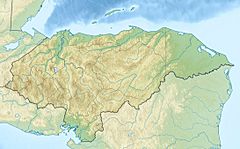Río Negro (Central America) facts for kids
Quick facts for kids Rio Negro |
|
|---|---|
|
Location of mouth
|
|
| Country | Honduras, Nicaragua |
| Physical characteristics | |
| River mouth | 13°01′07″N 87°18′10″W / 13.0187°N 87.3028°W |
The Río Negro (which means "Black River" in Spanish) is a river that helps divide the countries of Honduras and Nicaragua. It flows along the Pacific coast, acting as a natural border between these two Central American nations. Much of its path goes through a wild jungle area that is not very developed.
Contents
Where is the Río Negro?
The Río Negro is located in Central America. It forms part of the border between Honduras and Nicaragua. This means that if you are on one side of the river, you are in Honduras, and if you are on the other side, you are in Nicaragua! Rivers often make good natural borders because they are easy to see on a map.
The River's Journey
The river flows towards the Pacific Ocean. Its mouth, where it meets the ocean, is located at coordinates 13.0187 degrees North and 87.3028 degrees West. This area is often a mix of river water and ocean water, creating a special environment.
How Hurricane Mitch Changed the River
In October 1998, a very powerful storm called Hurricane Mitch hit Central America. This hurricane caused a lot of rain and flooding. The huge amount of water changed the path of many rivers, including the Río Negro.
The Impact of the Storm
Before Hurricane Mitch, the river followed a certain path. But after the hurricane, the river's course was "substantially altered." This means the river dug new channels and moved its banks. This kind of change can affect the land around the river and even the exact location of the border between countries.
Life Around the Río Negro
The area around the Río Negro is mostly a jungle region. This means it's filled with thick forests and many different kinds of plants and animals. Because it's "undeveloped," there aren't many towns or cities right along the river.
The Jungle Environment
Jungles are important ecosystems. They are home to a huge variety of wildlife, from colorful birds to unique insects and mammals. The river provides water for these animals and helps the plants grow. It's a wild and natural place.
See also
 In Spanish: Río Negro (Centroamérica) para niños
In Spanish: Río Negro (Centroamérica) para niños


